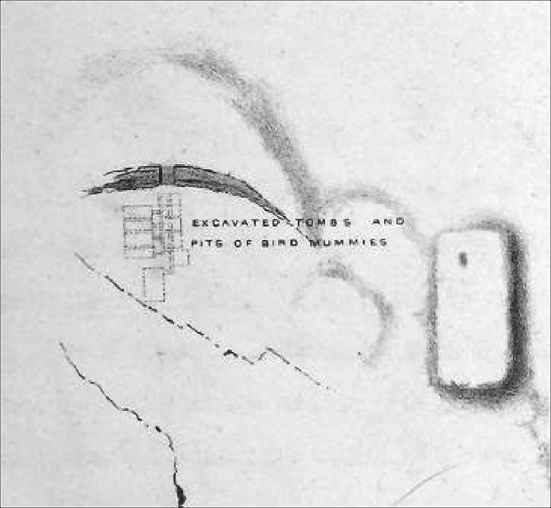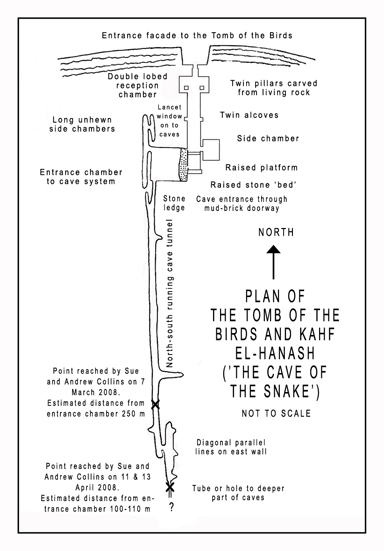![]()
![]()
WHERE
NEXT WITH GIZA'S CAVE UNDERWORLD?
Reviewing
the Exploration of Giza's Cave Complex in the Wake of Chasing Mummies Episode
"Bats"
by Andrew Collins
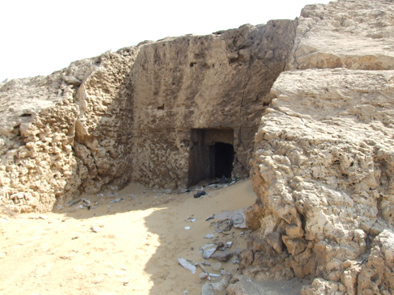
Entrance
to tomb NC2, the Tomb of the Birds (pic credit: Andrew Collins)
For the first time, finally, the public has had the chance to see what myself, Egyptological researcher Nigel Skinner Simpson and my wife Sue found and explored back in 2008 - Giza's previously unrecorded cave complex. In an episode of the History Channel television reality show Chasing Mummies, broadcast on September 1, 2010, Dr Zahi Hawass, along with an assembled team that included a full camera crew, were seen investigating the caves for an estimated distance of 300-350 feet. Their goal was to disprove the "pyramidiots" who believed that previously unknown caverns located in Giza's north cliff reached all the way to the main pyramid field, several hundred metres away.
Vyse
and Perring
It was in 1837 that the large tomb, through which the caves
are accessed, was examined by British explorer Col. Richard Howard Vyse and engineer
John Shae Peering. Vyse recorded that on May 3 the mummy of a "large bird"
was "carefully" removed from the tomb's interior (Vyse, I, 238), while
Perring's subsequent plans of the site indicate a complex structure now known
to be on two levels, next to which he wrote the word "Excavated tombs and
pits of bird mummies" (Vyse, 1840, I, I; Perring, 1839-42), indicating that
more than simply one bird mummy was found at the site.
In January 2007
Sue Collins and I visited the tomb, which does not appear to have been mentioned
in any publication since Vyse and Perring's day. I was intrigued by the site's
possible use as a bird necropolis, and discovered that within the tomb walls are
a number of horizontal slots that were probably used for the interment of birds,
and also small animals, perhaps left as offerings to a bird-related deity (Collins,
2009).
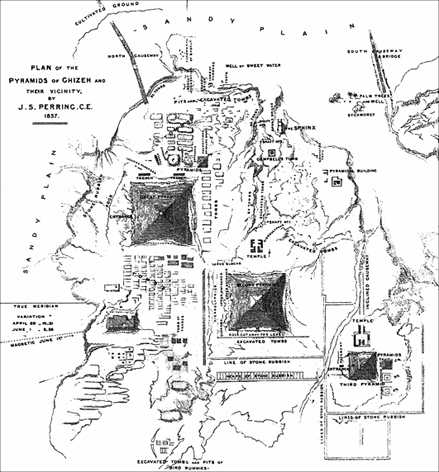 |
Left, John Perring's plan of the plateau at Giza, 1840, with the Tomb of the Birds (NC2) marked at the bottom. Above, section of Perring's folio plan published 1839-42 showing his more detailed rendition of the tomb and its subterranean level. |
Just
a few months after our visit to the tomb British diplomat and explorer Henry Salt's
memoirs were published in full for the first time, having languished unnoticed
in the British Museum until the library and archives of the Department of Ancient
Egypt and Sudan were being relocated in 2002. They record how in 1817 he and Italian
explorer Giovanni Caviglia travelled "several hundred yards into the rock"
before coming across a "spacious chamber" that "communicated with
three others of equal dimensions" (Usick and Manley, 2007, 62 - see full
quotation below) Afterwards, Caviglia followed another direction journeying "300
feet further" before giving up, having found nothing of consequence.
Tomb
of the Birds
Nigel Skinner Simpson was able to work out the entrance
to Salt's catacombs which we quickly realised coincided with the entrance to the
tomb explored by Vyse and Perring in 1837. This led to an expedition to investigate
the site, which I had now begun to refer to as the Tomb of the Birds. This took
place in March 2008 under the sponsorship of the A.R.E., the research wing of
the Edgar Cayce Foundation. On this occasion we finally found the entrance to
Salt's catacombs, which we explored in all on four occasions - twice in March
and twice more in April that year. We journeyed for a distance of around 300-350
feet, enabled me to draw a detailed plan of the system which I concluded was natural
in origin. Dr Hawass was informed of our discovery of the cave system in October
2008 by A.R.E. director John van Auken during a personal meeting. Hawass admitted
being unaware of the caves' existence, and thanked van Auken for bringing the
matter to his attention (1).
Sue Collins and I met Dr Hawass in April 2009
to discuss the matter further, and to present him with a comprehensive report
on the tomb as the proposed site of Salt's catacombs (Collins and Skinner-Simpson,
2008). He was also shown photographic evidence of the cave system. Yet by then
his attitude had changed and he now claimed that the tomb in question was already
known and fully recorded. I begged to differ and tried to discuss the matter of
the caves, but in all honesty he didn't seem to be listening, even though I sensed
that he had no real knowledge of their existence.
No
Cave Complex at Giza
The discovery of the caves went on to feature
in my book Beneath the Pyramids, published in October 2009. Yet as early
as December 2008 the story had started to leak on to the internet, something that
was to reach epidemic proportions by the summer of 2009, with thousands of webpages
mentioning the cave discovery in some capacity. Such an incredible response finally
prompted Dr Hawass to make a public statement in a blog posted in September 2009.
Under the heading "Collins' Cave Controvery" he voiced his opinion that
our party had simply got confused inside a previously recorded tomb, thinking
it larger than it actually was, adding that "there is no underground cave
complex at this site" (2).
What the world was not told, however, is
that Dr Hawass had by now ordered a full investigation of the tomb which took
place through until the end of the year. The excavation team uncovered staircases
in lobes on either side of the tomb's reception area. Each led down into an extensive
subterranean level that stretches beneath the tomb and continues towards the south.
Among the architectural features noted is a long central gallery, orientated north
south, with carved pillars running down the middle. On both the east and west
side of this large gallery are a series of hewn compartments. The staircases leading
to this lower level, last known to have been explored by Vyse and Perring in 1837,
were completely concealed by sand and debris during our own visits to the site
in 2007 and 2008.
In September 2009 with the interest in the cave-tomb
now at a height, Peter de Manuelian, Director of the Giza Archives Project, uploaded
to the Giza Archives Blog a previously unpublished plan of the Tomb of the Birds,
made in 1939 by Harvard University-Boston MFA expedition draftsman Alexander Floroff.
Here it is referred to under the designation NC2 (north cliff 2, with NC1 and
NC 3 being other smaller tombs in Giza's north cliff). Strangely, in this rough
plan, as well as in another example subsequently discovered by Nigel Skinner-Simpson
in the expedition field diary, only the upper level of the tomb is shown, without
any indication of the presence of either the caves or the lower level. Reisner's
team would appear to have made a partial clearance of the upper tomb, even whitewashing
its walls so that it might be used as an air-raid shelter for his work force during
World War II.
Do
Me a Favour
How exactly the TV series Chasing Mummies came to explore
the tomb NC2 in search of Giza's cave world is unclear. At the beginning of the
episode, aptly entitled "Bats", Dr Hawass asks executive producer Leslie
Greif to do him one final favour before he retires. He wants to prove the "pyramidiots"
wrong, for they say there are caverns that stretch all the way to the Pyramids.
It is an idea, I have to say, that I am responsible for. I wrote online about
a radar satellite image of the plateau created by the German TerraSAR-X satellite
which could mark the extent, position and orientation of the caves explored in
Giza's north cliff. The caves' presence seems to be echoed by a shadow line that
has no corresponding feature on the ground. More intriguing is the fact that this
shadow line connects with another that extends eastwards toward the Second Pyramid
- but more on this below.
The
Caves Are This Way
The starting premise of the Chasing Mummies' episode
"Bats" is that Dr Hawass knew already about the existence of caves at
tomb NC2. Yet anyone who watches Hawass's entry into the caves or sees his reactions
to the hundreds of bats that inhabit the place will realise very quickly that
he had little, if any, prior knowledge of the site. This I know for sure, for
what the viewer of Chasing Mummies does not see is that when Hawass arrives at
the tomb, intent on disproving the pyramidiots, he starts to descend the newly
uncovered stairs leading down in the lower level at the front of the tomb, and
has to be told: "No, Zahi, the caves are this way." A helpful hand then
directs him toward the rear of the tomb where a small breach in the stone wall
leads into the caves proper.
Even after Hawass enters the cave's opening
chamber, which has been clearly hewn in an attempt to give it a more rectilinear
appearance, he remains adamant that any passageway entered will go nowhere. When
a member of the team explores two such compartments, which do indeed lead to dead
ends, Hawass's response is simply "Good", as if he has heard enough
-the "pyramidiots" are indeed wrong.
The
Caves Are Natural
Zahi now leads the team into the main north-south
orientated cave tunnel, which heads into the bedrock at an estimated depth of
15-20 metres below the surface of the plateau. Very quickly we get the first true
revelation of the exploration, for the more astute members of the team start to
realise that the cave passage is natural in origin. One member asks: "Do
you think this is natural? It's got to be?" Dr David Cheetham, the show's
consulting archaeologist, responds by saying: "You see how this is water
worn. This is the result of pluvial action. Water moving through it. Notice here."
You see him rub his hand across the smooth surface of the cave wall. "This
is typical of water worn limestone in a cave environment. I've seen it lots and
lots of times in Central America."
Hawass, having heard this, responds:
"Allan, do you think this is natural?"
"I'm thinking maybe it
could be", Allan Morton, fellowship coordinator and archaeologist, responds.
"Karst erosion and karst features. This could be natural."
Plan of the tomb NC2 and caves drawn by Andrew Collins following his own exploration of the complex in 2008 (pic copyright: Andrew Collins). | I
Hate Bats! |
Through
the Stone Tube
Ahead of the team now was an enigmatic stone tube at
ground level that continues into the bedrock towards the south. It is just wide
enough to take the bulk of a human body. During our final visits here in April
2008, we had reached this same point but had decided against venturing further.
I did not want to put either myself or Sue (Nigel remained as our anchor inside
the tomb) into a potentially dangerous situation many hundred of feet underground.
Plus on our final visit Sue thought she had heard the sound of something moving
about beyond the end of the tube, which is approximately 12-15 feet long. In retrospect,
we both wish we had taken the plunge and gone through, but nothing now can change
the fact that this didn't happen. However, as I relived this epic cave journey
through the camera lens, I knew that there was no way that the Chasing Mummies
team were not now going to go through that hole.
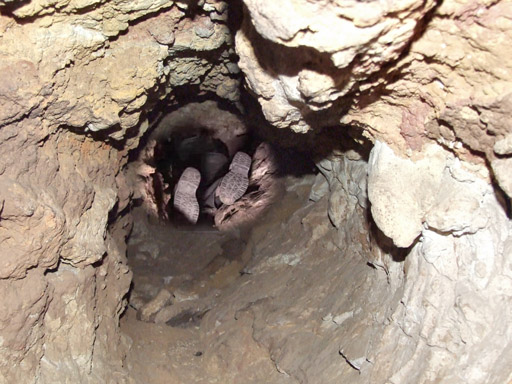
David
Cheetham as he disappears into the stone tube
at the end of Gza's cave complex
(pic credit Andrew Collins/Chasing Mummies/Rodney Hale).
David
Cheetham is then seen crawling into the tube. What would he find? I have certainly
speculated that there might be a cave chamber beyond this point, but would this
prove to be the case?
"What do you see?" Hawass is heard to say.
"Nothing
yet," comes the response from the hole, "give me a second."
The
camera then pans to Hawass, a flashlight illuminating his face in dramatic fashion.
"I have never made any adventure like this at Giza before," he admits.
"Really?",
one of the crew responds.
"I felt that the five [relieving] chambers
and the Sphinx tunnel [were adventures?] but that is amazing. I went in other
directions of the tunnel but I never thought that it goes as long as 300 feet."
Wow,
what an admission on Hawass's part.
It
Ends There
"David's what's happening?" Hawass calls out,
reminding us that David Cheetham was last seen disappearing into the tube.
"Oh
crap," is the slightly worrying response. "Getting stuck."
There
are tense moments before David comes out of the tube, feet first.
"Tell
me. What did you see there?" Hawass asks, eager to know the answer.
David's
response is deflating: "It ends there."
Not words I wanted to
hear.
Okay, maybe I just had to accept that there really isn't anything
beyond that tube, implying that the caves do indeed end here.
Satisfied
that they had reached the end of the cave tunnels, Hawass makes his pronouncement
on what he has seen here today: "Okay, I think, in my opinion now, the first
part when we entered [i.e. the tomb and opening chamber]. It's manmade. The second
part is natural. It's not manmade. But they used it later in the Late Period and
Roman Period for the burials of animals and things like that."

Screen shots from the Chasing Mummies episode "Bats" (pic credit: Chasing Mummies/Rodney Hale).
Lost
Necropolis
So there you have it. We have a dynastic tomb that cuts
into a natural cave system that was then used in Late Dynastic and Roman times
as an animal necropolis, which parallels very well my conclusions in Beneath
the Pyramids.
After making his pronouncement, Hawass is led out the
caves and back to his waiting SUV. The Chasing Mummies team then gather to debate
the day. They agree that it is mission accomplished - the pyramidiots have been
proved wrong. There is no cave tunnel leading to the Giza Pyramids. However, David
Cheetham, at least, seems impressed by the existence of the caves, which he clearly
sees as natural in origin.
A
Playground for Pyramidiots
As a consequence of the airing of the Chasing
Mummies episode on the caves, I think it possible that the viewing public are
going to be bamboozled by what they have seen here. I don't think they will know
whether to take the matter seriously or not. Any similar cave system found elsewhere
in Egypt would be seen as an important discovery, particularly if associated with
a rock-cut tomb of dynastic origin. However, at Giza everything is different.
Here it is dismissed as a playground for pyramidiots searching for the fabled
Hall of Records. This is a very sad state of affairs, and all I hope is that one
day someone will realise that the discovery of a natural cave system beneath the
plateau at Giza is indeed important, especially if it was accessible during the
Pyramid age.
I think the way forward is to start asking what the dynastic
Egyptians, the Greeks, the Romans and the Arab world might have thought about
the presence of caves at Giza (Dr Hawass revealed that two Roman coins were found
inside the cave's opening chamber, the Dome, showing that it must have been open
at this time). I am sure the caves would have been seen as sacred and significant,
meaning that we might have here an important cult centre, one unique perhaps to
Egypt. Evidence of this is in the fact that the tomb, its lower level and arguably
even the caves themselves, were used as a bird necropolis, implying that the site
was sacred to some local deity.
Tomb
of Hermes
The identity of that deity will depend on the identity of
the bird species found to have been interred here. From the apparently "large"
size of the specimen removed by Vyse and Perring in 1837, the most likely answer
is that it was the ibis, interred at cult sites in Egypt as part of the cult of
Thoth, or indeed his Graeco-Roman equivalent, Hermes, who was seen as a legendary
founder of Egyptian civilization. It is my surmise that in Greek and Roman times,
and arguably much later still, the Giza cave complex was seen as the entrance
to a symbolic tomb of Hermes. Medieval Arab writers record that the Sabaeans of
Harran came to Giza on pilgrimages in order to venerate the cave-tomb of Hermes,
which was thought to be located either in or beneath the Second Pyramid. In addition
to this, we know from the records of various early travellers to Egypt that in
the proximity of the Giza Pyramids were various place-names that included variations
of the name Hermes.
Assuming
a connection between the caves and the Graeco-Roman cult of Hermes makes sense,
although we will only know whether this is correct or not after we learn, finally,
the type of bird that was interred here. Hopefully, the excavation team's recent
clearance of the tomb's lower level might provide the evidence we need. |
Hermes, legendary founder of Egyptian civilization, whose tomb was thought to exist at Giza. |
Looking
for Caves in the X-band
As to whether the caves do continue after the
300-350 feet explored so far is going to remain a matter of debate for some time
to come. As previously mentioned, a radar satellite image of the Giza plateau
seems to show unidentified ground features on the west side of the plateau. The
image in question was created on July 2, 2007 by the TerraSAR-X satellite, operated
by a public-private partnership between the German Aerospace Center (DLR) and
Infoterra/Astrium GmbH of Friedrichshafen. To achieve these images the satellite's
operating system utilises an X-band signal, which records ground features in high
resolution.
The TerraSAR-X image shows a shadow line with a ground width
of no more than 5-10 metres that stretches from the north cliff, coincident to
a position of tomb NC2, southwards for a distance of around 50-75 metres. The
shadow corresponds to the position and orientation of the caves explored so far,
although not necessarily their entire length.
Of course, this could all be
simply coincidence, and unfortunately we do not have available any other high
resolution radar satellite images to confirm whether the shadow line appears here
too. This is unfortunate, however, the evidence from the Terra SAR-X image should
not be ignored.
Ground
Penetration
Generally, X-Band radar signals are not considered helpful
in recording sub-surface features due to the short wave frequencies employed,
with L-band signals being the preferred frequency range employed for this purpose.
Despite this, the partnership behind the TerraSAR-X satellite make it clear that
their X-band images can be used to determine sub-surface features. Yet due to
the moisture content of sand or soil, the ground penetration of the X-band signal
is usually no more than a few millimetres or centimetres deep, but under extreme
dry and sandy conditions, like that in desert environments, the signal can penetrate
to depths of up to several metres (3). However, the TerraSAR-X partnership admit
that they do not possess any precise data on this matter, leaving it possible
that the shadow line corresponding to the location of the caves might indeed reflect
their presence, even though the system is up to 15-20 metres beneath the surface.
If
this is difficult to believe, then fear not as there is another possible explanation.
Caves created by water action often follow the course of localized sub-surface
faulting. This could mean that what the TerraSAR-X radar image has caught is surface
or close surface fractures or subsidences indicating the presence of faulting,
which could correspond to the position of the caves.
If this might be accepted, then it brings in other more interesting data, for the TerraSAR-X image shows that towards the southern end of the aforementioned shadow line, two more shadow lines can be made out as thick curving lines, perhaps 10-15 metres in thickness. They begin close together, but then break away from each other to curve across to the Second Pyramid. The upper curve reaches the north side of the pyramid, towards its western end, while the lower curve reaches the west side of the pyramid, close to its northwest corner. This last position is highly significant since it corresponds almost perfectly with the position and orientation of faulting detected in 1977 by a joint team from the Stanford Research Institute (SRI) and the Ain Shams University, Cairo. Under the leadership of geophysicist Lambert T. Dolphin ground penetration radar (GPR) equipment was used to search for subterranean structures at various sites on the plateau.

Left, section of the the TerraSAR-X radar satellite image of July 2, 2007, showing the curved shadow lines starting at the edge of the plateau's north cliff and heading across to the Second Pyramid. Middle and right we see the transition from the TerraSAR-X image into the Google Earth satellite image made the same day. The position of the tomb NC2 is marked with a downward arrow. Note the north-south shadow line in the proximity of the tomb and caves in the left-hand picture (Pic copyright: DLR and DLR/Rodney Hale).
The
team noted the presence of heavy faulting on the northwest corner of the Second
Pyramid, on its west side, and also detected the presence of previously unknown
chambers or cavities deep beneath the Second Pyramid. Two large cavities, or chambers,
21 metres and 33 metres below Belzoni's chamber were detected, along with another
anomaly 4 metres below the floor of the horizontal passage leading to Belzoni's
chamber. Anomalies were also recorded up to 6m deep around the perimeter at the
north-west end of the west face, the same general vicinity that the heavy faulting
was found (Dolphin, 1977).
When the diagram of the heavy faulting detected
by Dolphin in the northwest corner of the Second Pyramid is overlaid upon the
same part of the TerraSAR-X image we can see that the termination of the lower
of the curved shadow lines corresponds perfectly with the location and orientation
of the faulting. This is yet another good indication that the shadow lines on
the TerraSAR-X radar image record geological anomalies, most obviously the presence
of sub-surface faulting. Another firm indication that the curved lines are geological
in nature is that one of them appears to begin in the proximity of a cutting through
the escarpment marked the edge of the plateau's north cliff. This is located a
short distance west of tomb NC2.
The final piece of evidence that the curved
shadow lines could be geological in nature is the fact that they are aligned perfectly
with the northwest-southeast orientation of the Mokattam formation, the limestone
bedrock on which the pyramid field sits. This specific orientation of the bedrock
has been noted in connection with exposed fissures both in the area of the Sphinx
and Sphinx enclosure, and within the so-called Osiris Shaft beneath the causeway
serving the Second Pyramid. Such findings counter any suggestion that the shadow
lines could be previously unknown causeways serving the Second Pyramid, perhaps
during the time of its construction. This said, I am of course open to further
suggestions in this respect.
Above, the faulting (in red) discovered at the northwest corner of the west side of the Second Pyramid by the SRI/Ain Shams team in 1977 supperimposed on the TerraSAR-X radar satellite image (Pic credit DLR/Rodney Hale). It shows the clear correlation between the position of the lower curved shadow line reached the pyramid and the location and orientation of the faulting. Right, diagram of the faulting at the northwest corner of the Second Pyramid as detected by GPR equipment in 1977 (pic credit: Dolphin/SRI/Ain Shams). | 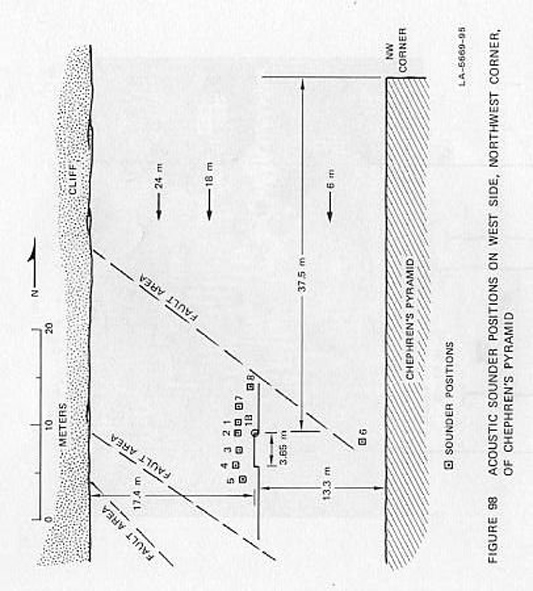 |
Although
it might thus be suggested that the shadow line marks a well trodden path, this
is quickly dispelled in the knowledge that the curve continues across to the Second
Pyramid and does not match up with any path seen on the corresponding Google Earth
map, which by chance was composed from satellite images taken the same day that
the TerrSAR-X satellite passed over the plateau - July 2, 2007.
Should
all this speculation prove meaningful, then it indicates that the caves beyond
tomb NC2, formed most probably by pluvial action, could extend in accordance with
the curved shadow lines of the TerraSAR-X image and reach the vicinity of the
Second Pyramid, making sense of the findings of the SRI/Ain Shams University survey
of 1977.
Reinterpreting
Salt's Memoirs
Yet whether access to a deeper part of the cave system
will ever be found remains to be seen. If no such access is achieved, what are
we to make of Salt's account of his exploration of catacombs for a distance of
"several hundred yards into the rock" before coming across a "spacious
chamber" that "communicated with three others of equal dimensions"?
Nigel Skinner-Simpson has proposed that the journey of "several hundred yards"
might refer, not to the distance travelled "into the rock", but to the
distance that Salt and Caviglia travelled across the plateau to reach the tomb
NC2 (Skinner-Simpson, 2009).
Above, Henry Salt (1780-1827), British diplomat and explorer. Right section of Salt's plan showing to the right of the words the curve of Giza's north cliff (Copyright credit: The British Museum). | 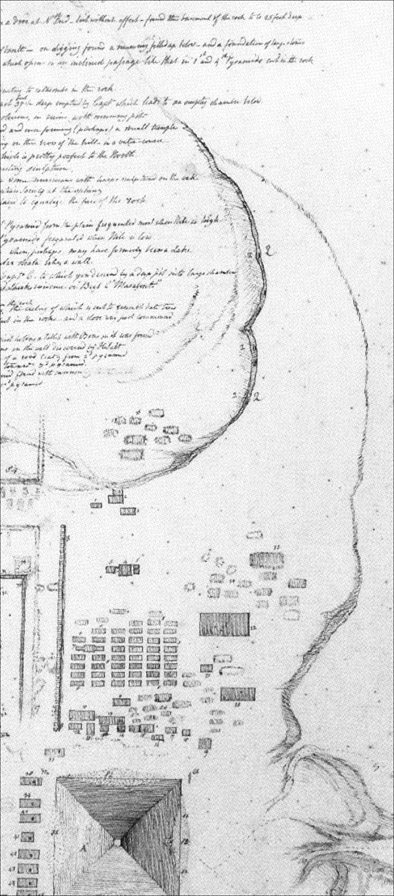 |
Skinner-Simpson
writes that when taken in context, "several hundred yards into the rock"
could mean that Salt and Caviglia visited a number of locations, moving ever further
away from the Pyramids. They eventually reached NC2 where Salt's statement about
entering "by a forced passage through a thin wall into a spacious chamber,
which presented nothing to our view, but bare and mouldering walls" might
well be an allusion to the two men entering through the small breach in the stone
wall that leads from the tomb into the opening chamber of the caves, the so-called
Dome.
The additional mention of Caviglia afterwards advancing "in
another direction, three hundred feet further", Skinner-Simpson offers, could
infer that Caviglia alone explored the caves proper, which we now know reach into
the bedrock for 300-350 feet, close enough to the estimated "300 feet"
of Caviglia's journey as recorded by Salt. At the time Skinner-Simpson was writing
his paper, news had yet to emerge of the exposure and excavation of the lower
level by the SCA team. Although not able to reconcile Perring's plan with what
he could see on the ground, he suggests that the "spacious chamber"
that "communicated with three others of equal dimensions" was connected
in some way with the four adjoining chambers shown on Perring's plan.
Nigel
might be correct, but there is an alternative explanation. This is simply to accept
the seemingly straight forward language Salt uses, and consider that he did indeed
journey "several hundred yards into the rock". Let's re-read Salt's
account as contained in his memoirs:
Respecting the Catacombs marked [Q.Q. - general ground plan] to the west of the Pyramids, I have little to say. We entered into one, and followed up our researches through rude and craggy vaults, several hundred yards into the rock, creeping at times on our hands and knees, among the bones, and carcasses of camels and other animals carried there by the hyenas, which frequent these caves. At last we entered by a forced passage through a thin wall into a spacious chamber, which presented nothing to our view, but bare and mouldering walls. This chamber communicated with three others of equal dimensions, whence issued many labyrinthick passages, which had too intricate and uninteresting an appearance to induce us to advance. Captain Caviglia informed me that he afterwards advanced in another direction, three hundred feet farther but found nothing to tempt him to continue his researches.The Portals to these Catacombs, are ornamented externally, and one of them, may be seen, from the path, before you mount up the hill on which the pyramids stand.(Usick and Manley, 2007, 62)
Perhaps there is some confusion in his words, but if we do take them literally then we should accept the possibility that he did indeed enter caves for a distance of several hundred yards. If this was the case, then as it stands we simply do not know how Salt and Caviglia gained access into any extended area of the cave system. All I can impress on those who follow up this research in the future is that they carefully examine every part of the tomb's lower level and the caves proper in order to see whether any previously unnoticed fissures or tubes lead into deeper parts of the cave complex. On top of this, the geological nature of the caves suggest that there should be other entrances into this system, which most likely permeates much of plateau's limestone bedrock. Since a metal gate has now been cemented into place across the entrance to the Tomb of the Birds, in order to safeguard its untouched archaeology and thriving eco-system for future generations, we should never tire of looking for these alternative entrances. Yet for the moment, and until any fresh information can throw new light on the mystery of Giza's cave underworld, I can only but see the matter as closed.
Andrew Collins, September 11, 2010.
Acknowledgments
Many thanks to Rodney Hale, for all his help and technical support in the creation of this article. I wish to thank Nigel Hetherington, Greg Little, Nigel Skinner-Simpson, Rodney Hale, Matt Kyd and Sue Collins, for reading the article and offering their editorial comments. I also thank everyone who has helped in spreading the word regarding our work at Giza, especially all our friends and supporters on Facebook.
Notes
and References
1.
Van Auken, John, "New Find in Egypt! "Edgar Cayce Team Finds Ancient
Passageways - Underground Caves Beneath the Pyramids", Venture Inward News,
at http://www.edgarcayce.org/are/news.aspx?id=2052
2.
Hawass, Zahi, "Collins' cave controversy", the website of Zahi Hawass,
at http://www.drhawass.com/blog/collins-cave-controversy.
3.
Email from Michael Eineder of DLR to the author dated June 1, 2010
Bibliography
Collins,
Andrew, Beneath the Pyramids, 4th Dimension Press, Virginia Beach, VA,
2009
Collins, Andrew, and Nigel Skinner-Simpson, "The Giza Catacombs -
A Possible Entrance Identified", unpublished, 2008.
Dolphin, Lambert T.,
A. H. Moussa et al, "Applications of Modern Sensing Techniques to Egyptology",
SRI Institute, Menlo Park, CA, September 1977
Perring, John Shae, The Pyramids
of Gizeh, from Actual Survey and Admeasurement. Illustrated by notes and references
to the several plans, with sketches taken on the spot, by E. J. Andrews, 3
parts in one vol., James Fraser, London, 1839-42.
Skinner-Simpson, Nigel, "An
Alternative Interpretation of Salt's Memoir", unpublished, 2009.
Usick,
Patricia, and Deborah Manley, The Sphinx Revealed-A Forgotten Record of Pioneering
Excavations, British Museum Press, London, 2007.
Vyse, R.W.H, Operations
Carried On At The Pyramids Of Gizeh, London, 1840-2
For
those who wish to see the Chasing Mummies episode "Bats", featuring
the Giza cave complex, use the link below. A HD file can be accessed free by using
the slow download button at the bottom right of the webpage. Press it and you
will see a 30 second countdown. The button will then return. Press it again, and
the download will begin.
http://www.fileserve.com/file/dm8X4ve/chasing.mummies.s01e08.hdtv.xvid-fqm.a
See
the recent press release on Andrew Collins's response to the Chasing Mummies episode
"Bats"
http://www.prlog.org/10905581-pyramids-cave-world-discovered-at-giza.html
Buy
BENEATH THE PYRAMIDS from Amazon by clicking here.
Buy
direct from the US publisher, 4th Dimension Press, by clicking here.
Buy
BENEATH THE PYRAMIDS direct from the author by clicking
here
